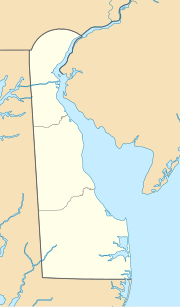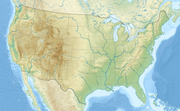Deep Creek is a 4.22 mi (6.79 km) long 2nd order tributary to the Appoquinimink River in New Castle County, Delaware.
| Deep Creek Tributary to Appoquinimink River | |
|---|---|
| Location | |
| Country | United States |
| State | Delaware |
| County | New Castle |
| Physical characteristics | |
| Source | Bohemia River divide |
| • location | about 1 mile southwest of Middletown, Delaware |
| • coordinates | 39°25′18″N 075°44′58″W / 39.42167°N 75.74944°W[1] |
| • elevation | 45 ft (14 m)[2] |
| Mouth | Appoquinimink River |
• location | about 1.5 miles southwest of Odessa, Delaware |
• coordinates | 39°26′20″N 075°40′44″W / 39.43889°N 75.67889°W[1] |
• elevation | 0 ft (0 m)[2] |
| Length | 4.22 mi (6.79 km)[3] |
| Basin size | 7.52 square miles (19.5 km2)[4] |
| Discharge | |
| • average | 8.60 cu ft/s (0.244 m3/s) at mouth with Appoquinimink River[4] |
| Basin features | |
| Progression | generally east |
| River system | Appoquinimink River |
| Tributaries | |
| • left | unnamed tributaries |
| • right | unnamed tributaries |
| Waterbodies | Silver Lake |
| Bridges | Levels Road, DE 71, Silver Lake Road |
Variant names
editAccording to the Geographic Names Information System, it has also been known historically as:[1]
- North Appoquinimink River
Course
editDeep Creek rises on the Bohemia River divide about 1 mile southwest of Middletown in New Castle County, Delaware. Deep Creek then flows east to meet the Appoquinimink River about 1.5 miles southwest of Odessa, Delaware.[2]
Watershed
editDeep Creek drains 7.52 square miles (19.5 km2) of area, receives about 43.2 in/year of precipitation, has a topographic wetness index of 632.96 and is about 2.5% forested.[4]
See also
editReferences
edit- ^ a b c "GNIS Detail - Deep Creek". geonames.usgs.gov. US Geological Survey. Retrieved 2 March 2020.
- ^ a b c "Appoquinimink River Topo Map, New Castle County DE (Taylors Bridge Area)". TopoZone. Locality, LLC. Retrieved 2 March 2020.
- ^ "ArcGIS Web Application". epa.maps.arcgis.com. US EPA. Retrieved 1 March 2020.
- ^ a b c "Deep Creek Watershed Report". Waters Geoviewer. US EPA. Retrieved 2 March 2020.

